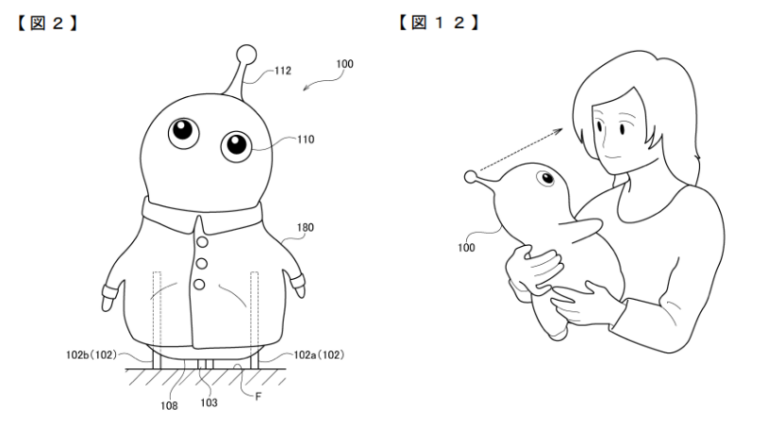
- Overview of the Patent Drawing
- Patent Insight 1: Designed for Emotional Bonding and Comfort
- Patent Insight 2: Movement Mechanisms for Enhanced Interactivity
- Patent Insight 3: Antenna and Clothing Elements for Added Appeal
- Patent Attorney’s Thoughts
- Keywords
- Application of the Technology: “Robo-Monk Plush for Automated Temple Blessings”
Overview of the Patent Drawing
The illustrations depict a plush robot (100) designed for physical interaction and emotional engagement. Figure 2 shows the robot in a standing position, featuring a rounded body, large expressive eyes (110), an antenna-like appendage on top of its head (112), and a soft outer covering resembling clothing (180). The robot’s base includes movement mechanisms (102a, 102b) and a support structure (108). Figure 12 illustrates a person holding the robot, indicating its suitability for close physical interaction, such as hugging or cradling.
Patent Insight 1: Designed for Emotional Bonding and Comfort
The plush robot’s soft exterior and rounded, friendly appearance, as shown in Figure 2, are likely designed to evoke feelings of comfort and emotional bonding. The large eyes (110) contribute to a cute and expressive look, helping to establish a connection with users. The robot’s size and shape are suitable for being held or hugged, making it ideal for settings such as therapy, childcare, or companionship for elderly individuals. Its design encourages physical interaction, which can be important for emotional support applications.
Patent Insight 2: Movement Mechanisms for Enhanced Interactivity
The base of the robot features movement mechanisms (102a, 102b), which suggest that the robot can perform simple movements or adjustments, such as rotating or swaying. These movements can enhance the robot’s interactivity by responding to the user’s actions or mimicking human-like behaviors. For example, the robot might sway gently when held or move its arms to simulate a hug, providing a more engaging and lifelike experience.
Patent Insight 3: Antenna and Clothing Elements for Added Appeal
The antenna-like appendage (112) on the robot’s head and its clothing-like covering (180) add to its playful and approachable design. The antenna could serve a functional purpose, such as housing sensors or lights to indicate the robot’s status or reactions. Meanwhile, the clothing could be customized or changed, adding a layer of personalization and making the robot feel more like a companion or character. This personalization potential could make the robot more appealing to children or individuals who enjoy customizing their belongings.
Patent Attorney’s Thoughts
Upon reviewing the patent drawing for the “Plush Robot for Emotional Interaction and Physical Engagement,” I was immediately struck by its endearing design and the thoughtful integration of features aimed at fostering emotional connections.
The robot’s rounded body, large expressive eyes, and soft exterior evoke a sense of comfort and approachability, reminiscent of cherished childhood toys.
What particularly resonates with me is the robot’s potential to serve as a companion in therapeutic settings.
Its design seems tailored to provide solace and companionship to individuals who may benefit from emotional support, such as children or the elderly.
The inclusion of movement mechanisms suggests an ability to respond to touch or presence, adding a layer of interactivity that could enhance the user’s sense of connection.
The antenna-like appendage and clothing elements add a playful charm, inviting personalization and further bonding.
I can envision users dressing the robot or attributing personalities to it, much like they would with a beloved pet or doll.
In a world where human interaction is increasingly mediated by technology, this plush robot stands out as a heartwarming bridge between the digital and the emotional.
It embodies a gentle reminder that technology, when designed with empathy, can touch our lives in profoundly human ways.
Keywords
plush robot, emotional support, interactive robot, movement mechanisms, companionship, child-friendly design
Application of the Technology: “Robo-Monk Plush for Automated Temple Blessings”
Purpose
To repurpose the emotional and physical interaction functions of the plush robot into a “Robo-Monk” installed in unmanned urban temples. It offers spiritual comfort, gentle guidance, and warm cuddles in the absence of human clergy.
System Components
- Plush Monk Body: A serene, cushion-seated plush resembling a Buddha statue, with embroidered closed eyes and calm smile.
- Emotion Sensor: Detects visitor presence, facial expressions, and time spent in front of the altar to tailor verbal output.
- Physical Interaction Mechanism:
・Shake hands = calming hum + “Namuuu…”
・Belly press = whisper “Gratitude for your karma…” - Mode Switch:
・“Peaceful” = Slow chanting
・“Tough Love” = “That’s your ego talking.”
・“Zen Silence” = Occasional blink, mostly silence
Operational Flow
- Visitor enters unmanned temple hall
- Robo-Monk activates with a soft chime and bows slightly
- Reaches out for hand-holding, begins conversation with “Welcome, wanderer…”
- Adapts tone and responses based on interaction
- After a session, powers down with a final “May all beings be well…” and returns to meditative slumber
A future where even enlightenment can be fluffy.
Disclaimer: This content is an AI-generated reinterpretation based on a patent drawing.
It is provided for educational and cultural purposes only, and not as legal advice.



